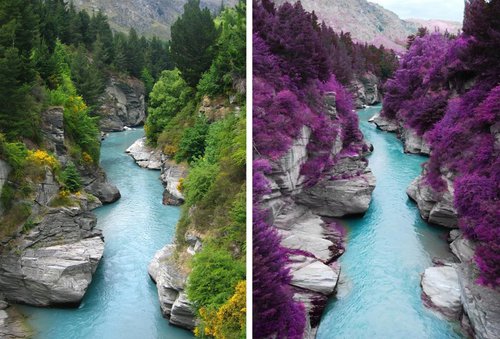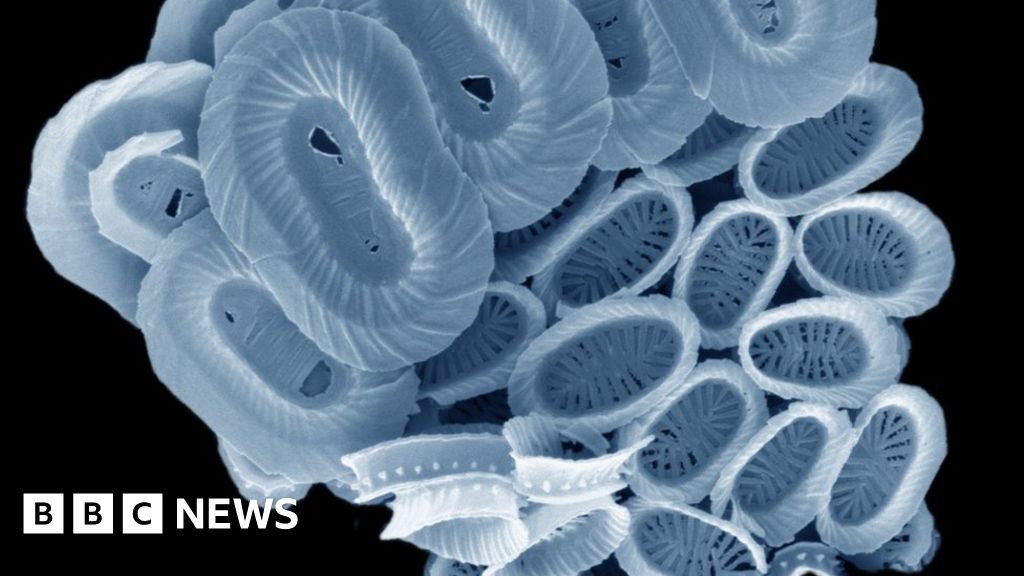Intense, bright red algae was spotted in a Cocoa Beach canal near Minuteman Causeway, prompting concerns from neighbors. Wochit
Story update: (1:35 p.m., April 26, 2018)
COCOA BEACH — The creature turning a few Indian River Lagoon canals here tomato-soup red, which officials had suspected was an animal, turns out to be a plant.
Today, officials with the St. Johns River Water Management District said tests at University of Florida identified the algae as Fibrocapsa japonica.
The same species bloomed in August 2011 in the mangroves east of Tarpon Bay on Florida's Gulf Coast.
The current bloom in Cocoa Beach canals is not “the” toxic red tide species of algae, Karenia brevis.
But the same algae has caused major fish kills around the world, according to the Florida Fish and Wildlife Conservation Commission. And outside of Florida, it has been known to produce brevetoxins, the same toxins taht red tide emits, which can kill marine life and cause itchy throats and respiratory symptoms in humans.
St. Johns officials said of the current bloom that there is “no certainty of toxicity.”
Today, a canal near Sunset Road resembled tomato soup through the mangroves.
District officials said the UF tests showed Fibrocapsa japonica as predominant species causing the redness in the water, but that other species of marine organisms may be contributing as well.
Original story:
COCOA BEACH — A one-celled critter that uses tiny vibrating hairs to dash to and fro turned canals here in the past few days a deep blood-red reminiscent of something out of the Old Testament.
"It's almost Biblical," said Duane DeFreese, executive director of the Indian River Lagoon Council. "It's different. It's not known to be toxic. It's probably feeding on the brown tide (algae)."
Dozens of catfish and other species floated motionless in the crimson water, dead, and some bearing red streaks that resembled blood across their white underbellies.
While tests are pending, the most likely suspect is a protozoan called Myrionecta rubra, officials said. Tiny hairs called cilia propel this wily critter through the water. It employs the same hairs to ensnare algae it stores for later, borrowing the algae's photosynthetic structure to make food.
It is not "red tide," but can kill fish by depleting oxygen in the water. Experts aren't sure how long it might persist.
"It's the only thing we've come across that gets that color," said Charles Jacoby, supervising environmental scientist for the St. Johns River Water Management District.
Tests results for a more definitive determination are expected in a few days.
The suspected species has turned patches of coastal waters in Brevard red in recent years, including small patches of the lagoon in 2014 and 2017.
In January 2014, a satellite captured an image of a bloom of the microscopic organisms off the southeastern coast of Brazil, stretching some 500 miles.
By Wednesday afternoon, the blood-red color was already dissipating, settling into a murky brown. Brevard County officials who monitor oxygen levels in area waterways collected a sample of the water and sent it to the University of Florida for further testing to make a final determination of what caused the coloration.
“We are aware of it we have inspected it and we have contacted the county to see what they believe is the problem...it’s in an isolated area,” Melissa Byron, the marketing director for Cocoa Beach, said earlier when reached by FLORIDA TODAY.
Canals along the causeway started turning blood red two days ago, city officials said. Residents began noticing the color change shortly after heavy rains that passed through two days ago.
More: Not again: Dreaded fish kill begins in Brevard
More: 6 months after Irma, sewage issue lingers; we may see another major fish kill
Shore birds and gulls eating dead and dying flounder floating in Cocoa Beach. Video by Malcolm Denemark, FLORIDA TODAY Posted Aug. 27, 2017
This "blood bloom" may be feeding off the brown tide algae that has been a scourge on Brevard County for months.
"It's so sad," Stephanie Reneberg, said Wednesday, rolling up on her bicycle on the Minutemen Causeway sidewalk, between Aucila Road and Sunset Drive.
"I'm mad and sad about it," Reneberg said, straddling her bike, gazing at several white, belly-up catfish floating among the mangroves in a crimson, lazy canal. A short distance away, at Reneberg’s condominium near the city golf course off Minutemen, the water looks like chocolate, she said.
Closer, sunlight glistened off the crimson-colored surface, which also reflected cotton-like clouds.
Gerry Mollard, who has lived in Cocoa Beach for over 40 years, said he walked outside Tuesday and was immediately struck by how red the water was.
"It had an appearance of almost like something got dumped into it," Mollard said, adding that he spotted fish and manatees swimming in the water normally.
Those manatees are long gone, said Reneberg, who posted pictures of the foul red canals on a local Facebook page.
Her memories are still fresh from March 2016, when dead fish floated up in Cocoa Beach canals during the worst fish kill on record in the Indian River Lagoon. Fish died from Titusville to Palm Bay when a massive brown algae bloom crashed, and bacteria hogged oxygen from the water as they decomposed the dead algae.
The lagoon is poised for a potential repeat ofthat fish kill, experts warn.
“All the conditions are still ripe,” said DeFreese, of the Lagoon Council, who noted that they are reminiscent of 2016.
Last season's storms, such as Hurricane Irma, helped set the stage for fish kills, via large volumes of runoff pollution, he added, fueling this latest creature from the red lagoon.
"It's a strange little critter," he said.
Contact Waymer at 321-242-3663 or jwaymer@floridatoday.com or on Twitter: @JWayEnviro
Contact Gallop at 321-242-3642 or jdgallop@floridatoday.com or on Twitter: @JDGallop
Tyler Vazquez contributed to this report
Read or Share this story: https://on.flatoday.com/2FfkBcn
Baca Di sini Bro https://www.floridatoday.com/story/news/2018/04/25/red-bloom-hits-waters-near-minuteman-causeway-cocoa-beach/549727002/
















/data/photo/2013/04/02/1449148-virushpv-780x390.jpg)




